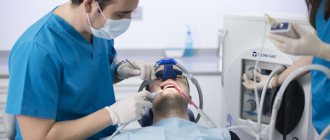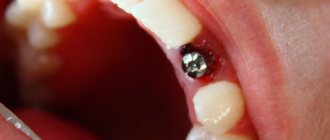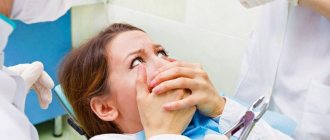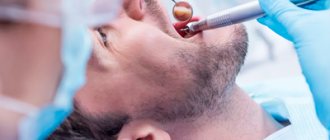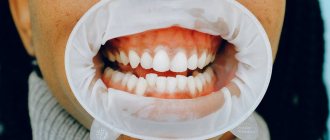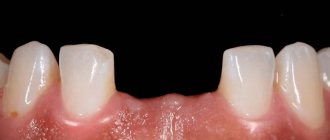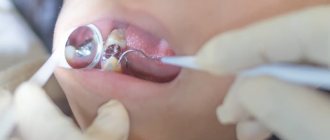Types of general anesthesia
Depending on the method of administering drugs for general anesthesia, inhalation and intravenous anesthesia are distinguished.
With inhalation anesthesia, the anesthetic enters the body through the respiratory tract; with intravenous anesthesia, it is injected into the bloodstream. A combined method involving inhalation and intravenous administration of the drug is actively used. To maintain external respiration, an endotracheal tube or laryngeal mask is used. The first method is called intubation anesthesia (or endotracheal), the second - mask. You will not need deeper knowledge about the specifics of an anesthesiologist’s work; it is much more important to understand how to properly prepare for anesthesia.
Good general anesthesia is the result of the consolidated efforts of the anesthesiologist and the patient. Therefore, we recommend that you read the next section very carefully.
Who is indicated for general anesthesia?
Dental treatment under general anesthesia is a complex and responsible procedure. It is carried out only for medical reasons, when it is not possible to use sedation in combination with local anesthesia.
In particular, general anesthesia is used for allergic reactions to all types of local anesthetics.
The decision on the need for dental treatment under general anesthesia is made by a dentist based on the results of an examination of the oral cavity and the collected medical history. The selection of the drug for general anesthesia and the calculation of the dose are performed by an anesthesiologist-resuscitator.
Before the procedure, the patient must undergo a full medical examination, undergo tests and have an ECG. Additionally, you may need to visit specialized doctors.
Before general anesthesia: preparation
Preparation for surgery under anesthesia has a great influence on the effectiveness and safety of general anesthesia and the course of the postoperative period. You will have to undergo a comprehensive diagnostic examination, including detailed blood tests, coagulogram, and ECG. According to indications, consultations with narrow specialists are prescribed.
The presence of chronic diseases of the respiratory and cardiovascular systems is of great importance. Be sure to tell your doctor about the following diseases:
- bronchial asthma;
- chronic obstructive bronchitis;
- arterial hypertension;
- IHD;
- history of stroke.
Do not under any circumstances hide the fact that you have a history of chronic diseases and acute vascular events (heart attack, stroke). Not only the outcome of the operation, but also your life depends on this! Also provide your doctor with a complete list of medications you take, including “harmless” analgesics for headaches or menstrual pain.
As practice shows, excess weight negatively affects the rate of recovery after operations under general anesthesia. If you are planning plastic surgery in advance, pay attention to weight loss issues. It is advisable to quit smoking in about six months. If you have not done this, stop smoking a week before the operation, but you should not “quit” the day before anesthesia - this may complicate the rehabilitation period.
On the eve of the operation, pay special attention to nutrition and hydration. You should not drink alcohol 24 hours before plastic surgery. On the day before surgery, you should limit yourself to breakfast and lunch. On the day of surgery, eating and drinking is strictly prohibited!
Anesthesia
Meeting with an anesthesiologist before surgery
To most people who are not involved in medicine, it seems that anesthesia is an injection that puts a person into a state of sleep.
In fact, we are talking about a whole range of measures aimed at creating physical and psychological comfort at all stages of the process: preparation, surgery, rehabilitation. After you have talked with the surgeon and decided to have the operation, you will undergo an examination at the GrandMed clinic in accordance with established standards. And a meeting with an anesthesiologist is mandatory. An appointment with this specialist includes filling out a detailed questionnaire, which asks general questions regarding the state of health in the past and present, and previous operations. It would seem like a formality. In fact, this information is very important. Correct assessment of health status is a fundamental aspect when planning the scope of surgery and choosing anesthesia.
Altshuller Mikhail Davidovich, anesthesiologist:
“I will never expose a patient to unjustified risk. It is better to do less or postpone the operation altogether than to suffer a complication. At the GrandMed clinic, any operation is taken very seriously. For us, it is not the flow that is important, but each patient individually. We use the most modern technologies and anesthesia, similar to those used in Europe and America. Since the 90s, we have been guided by the Harvard standard of patient monitoring, according to which an anesthesiologist and his assistants are present during the operation. The relevant indicators are constantly monitored: pulse, blood pressure, blood oxygen saturation, ECG. We use only proven anesthetic technologies and never rush. Therefore, our patients sleep well and wake up well. Trust me, you are in good hands."
There are three main types of anesthesia:
- general,
- local,
- regional.
In the global practice of plastic aesthetic surgery, most specialists prefer general anesthesia with the help of intravenous administration of appropriate drugs. It can be different. In some cases, breathing is controlled through an installed breathing tube, and artificial ventilation is performed. In other cases, the patient breathes on his own. Together with the surgeon, the anesthesiologist chooses the option that will best suit you. And the decision made is not subject to discussion, because it is a matter of reducing risks. Safety in this case comes first. If the upcoming operation is not classified as complex, then, if you agree, it can be done under local anesthesia. As a rule, these are operations to remove small scars or scars, papillomas and some others.
Altshuller M.D.:
“What is the main thing in the work of an anesthesiologist at a plastic surgery clinic?
Remember that in conventional medicine there are patients, and in aesthetic medicine there are patients. They are less patient with pain and inconvenience, they expect more sympathy and care, kind words. Therefore, in addition to adequate anesthesia, other points are important. Patients should be confident that they will not wake up during the operation, they will lie comfortably on the operating table, and after anesthesia there will be no chills or nausea, and they will quickly return to their normal state. Modern technologies make it possible to administer anesthesia in such a way that a person feels after surgery as if he had a good sleep: no pain, no chills, no discomfort.” Technology of general anesthesia (anesthesia) at the GrandMed Clinic: The patient, examined the day before and examined by an anesthesiologist, is admitted to the Clinic on the day of the operation. After marking the surgical field by the surgeon and preoperative examination by the anesthesiologist, the patient is given a system for intravenous administration of general anesthesia drugs and preoperative sedation (drip) begins. In a half-asleep, but adequate state (and in a good mood - without fear), the patient is admitted to the operating room (taken on a gurney), where general anesthesia begins.
How is the patient's condition under anesthesia monitored?
At the GrandMed Clinic, general anesthesia is performed by a team consisting of an anesthesiologist and a nurse anesthetist. In addition to face-to-face monitoring of the patient’s condition by these specialists, they also use hardware monitoring of at least five vital parameters: pulse rate, blood pressure, blood oxygen saturation, electrocardiography (plethysmography), body temperature, etc. At the end of the operation, the anesthesiologist reduces the dose of the incoming anesthetic until the point when the patient begins to wake up. After the tests are carried out, the patient is transported to the ward under round-the-clock supervision of a nurse and anesthesiologist, where he finally wakes up.
Anesthesia drugs:
GrandMed aesthetic surgery uses various options of general anesthesia and sedation. We mainly use intravenous anesthesia, which allows the patient to be put into a restful sleep in a dosed and controlled manner by the anesthesiologist (eliminating the possibility of unexpectedly waking up during the operation). After the operation, the patient comes out of anesthesia easily and at a time determined by the anesthesiologist. After anesthesia, the patient reacts adequately to what is happening, communicates with others, quickly begins to eat and drink (there is a good appetite without nausea), he does not have confusion, chills, dizziness or nausea.
Our anesthetic drugs:
At the GrandMed Clinic, the drug Diprivan (Propafol) is used for anesthesia. It allows reliable management of anesthesia and is well tolerated by patients.
DEAR PATIENT!
Please note that the tasks of an anesthesiologist-resuscitator at the GrandMed clinic include:
- preliminary consultation with you on the eve of the operation. Depending on the type of operation, its duration and your condition (test results, ECG, etc.), the anesthesiologist will choose one or another type of anesthesia that optimally meets the requirements for your safety and comfort
- Meeting with you before surgery in the ward, where your vital signs will be assessed again, and pre-sedation will be given to relieve stress (if desired)
- control and management of all vital functions during surgery - breathing, blood pressure, heartbeat, blood circulation, metabolism (using modern high-precision equipment)
- waking you up after surgery and monitoring your condition during the entire time you are in our ward
Important details of anesthesia:
As already mentioned, anesthesiological care is a set of measures aimed at ensuring safety and creating physical and psychological comfort for the patient at all stages of the process. Therefore, the anesthesiologist's area of responsibility extends beyond the operating room. The quality of sleep before surgery is of great importance. People tend to worry before such significant events. The task of an anesthesiologist is to reduce the level of anxiety and relieve a person from insomnia. If such a problem exists, it is important to inform your doctor about it in advance so that he can take appropriate measures. By taking sedatives before surgery, sound sleep is guaranteed, and you arrive at the clinic in a stable emotional state. It is very important. Especially if there are any associated problems, for example, a tendency to increase blood pressure. On average, after surgery, the patient spends one and a half days in the clinic, being under the constant supervision of medical personnel and receiving appropriate treatment, rehabilitation and care.
Preoperative examination (mandatory) before plastic surgery
Before performing plastic surgery of any degree of complexity in the plastic surgery department, the patient must undergo an initial examination in accordance with the Procedure for the provision of medical care in the “plastic surgery” profile, approved by order of the Ministry of Health of the Russian Federation dated October 30, 2012 N 555n
Preoperative examination (valid for 10 days).
- Clinical blood test
- Biochemical blood test: ALT, AST, glucose, bilirubin, creatinine, potassium
- Blood clotting time, bleeding duration, coagulogram
- Form 50, RW, HbsAg + HCV
- General urine analysis
- ECG
- consultation with an anesthesiologist (after test results and ECG are ready)
- test for measles and COVID-19
- blood type and rhesus
Additionally, your doctor may prescribe the following tests:
- Fluorography
- Densitometry
- External respiration function
- X-ray
- Rhinomanometry
- Mammogram
- Ultrasound of the mammary glands
- Abdominal ultrasound
- Duplex scanning of the veins of the lower extremities
- Computer tomogram
- Consultation with a mammologist-oncologist before any breast surgery
- Consultation with a dentist
- Consultation with a gynecologist (+ smears)
After general anesthesia
Even after a good general anesthesia, in the first hours there is short-term confusion, disorientation in space and time, drowsiness, nausea, and dizziness. As the anesthetic drugs wear off, pain appears in the postoperative wound, but it is successfully relieved by the administration of strong anesthetics.
After general anesthesia with an endotracheal tube, patients complain of pain and sore throat caused by irritation of the mucous membrane of the upper respiratory tract, but this symptom, like nausea, passes very quickly. As a rule, patients feel well 3-4 hours after surgery, and on the second day they leave the clinic and return home.
Dental treatment under anesthesia
General anesthesia in dentistry
In practice, it turns out differently. The understanding of the terms by the doctor and the patient, it turns out, is very different and, in order not to “spread the thought on the tree,” it is permissible to say that general anesthesia ( general anesthesia ) is when the patient sleeps deeply during a medical procedure. But with sedation , the patient is only “loaded” with sedatives, his consciousness is a little “foggy,” but he is not sleeping—he sees, hears and feels. If the patient has a panicky fear of dentists, fear of pain, a strong gag reflex, a large volume of planned intervention (5 – 8 – 10 or more teeth), mental illness or cerebral palsy, removal of a complicated wisdom tooth, maxillofacial surgery (sinus lifting, for example) , allergies to anesthetics - then the correct choice is general anesthesia - dental treatment in a state of deep sleep .


